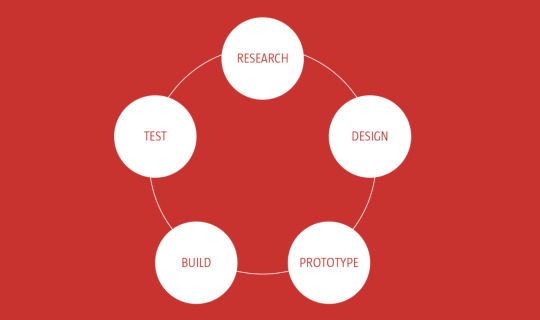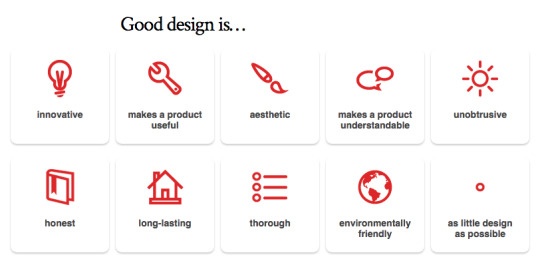Text
6 notes
·
View notes
Text
3 notes
·
View notes
Text
4 notes
·
View notes
Text
Size — Larger elements will dominate and catch eyes first.
Color — Bright colors catch eyes ahead of muted, drab ones.
Contrast — Stark differences between elements draw eyes to the brighter one.
Alignment — Users expect to find certain elements in the same place.
Repetition — A repeated quality (e.g.,colored parts of text) draws the user’s eye.
Proximity — Putting related elements (e.g., header with associated text) close together means these are related.
Whitespace — Including whitespace around elements singles them out as separate groups of information.
Texture and Style — Using distinct textures/styles (e.g., chunky, military-style buttons) draws the eye while setting the theme.
2 notes
·
View notes
Photo
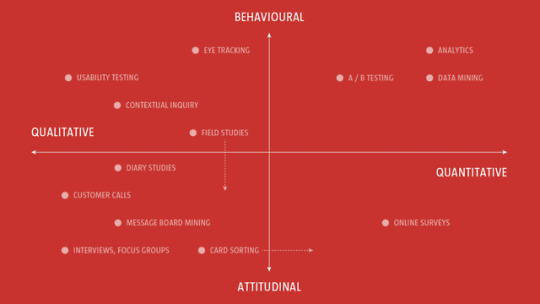
The Research Landscape
https://www.smashingmagazine.com/2018/01/comprehensive-guide-ux-research/
4 notes
·
View notes
Text
UX Research Cheat Sheet
Discover
The discovery stage is when you try to illuminate what you don’t know and better understand what people need. It’s especially important to do discovery activities before making a new product or feature so you can find out whether it makes sense to do the project at all.
An important goal at this stage is to validate and discard assumptions and then bring the data and insights to the team. Ideally, this research should be done before effort is wasted on building the wrong things or on building things for the wrong people, but it can also be used to get back on track when you’re working with an existing product or service.
Good things to do during discovery:
Conduct field studies and interview users: Go where the users are, watch, ask, and listen. Observe people in context interacting with the system or solving the problems you’re trying to provide solutions for.
Run diary studies to understand your users’ information needs and behaviors.
Interview stakeholders to gather and understand business requirements and constraints.
Interview sales, support, and training staff. What are the most frequent problems and questions they hear from users? What are the worst problems people have? What makes people angry?
Listen to sales and support calls. What do people ask about? What do they have problems understanding? How do the sales and support staff explain and help? What is the vocabulary mismatch between users and staff?
Do competitive testing. Find the strengths and weaknesses of your competitors’ products. Discover what users like best.
Explore
Exploration methods are for understanding the problem space and design scope and addressing user needs appropriately.
Compare features against competitors.
Do design reviews.
Use research to build user personas and write user stories.
Analyze user tasks to find ways to save people time and effort.
Show stakeholders the user journey and where the risky areas are for losing customers along the way. Decide together what an ideal user journey would look like.
Explore design possibilities by imagining many different approaches, brainstorming, and testing the best ideas in order to identify best-of-breed design components to retain.
Obtain feedback on early-stage task flows by walking through designs with stakeholders and subject-matter experts. Ask for written reactions and questions (silent brainstorming), to avoid groupthink and to enable people who might not speak up in a group to tell you what concerns them.
Iterate designs by testing paper prototypes with target users, and then test interactive prototypes by watching people use them. Don’t gather opinions. Instead, note how well designs work to help people complete tasks and avoid errors. Let people show you where the problem areas are, then redesign and test again.
Use card sorting to find out how people group your information, to help inform your navigation and information organization scheme.
Test
Testing and validation methods are for checking designs during development and beyond, to make sure systems work well for the people who use them.
Do qualitative usability testing. Test early and often with a diverse range of people, alone and in groups. Conduct an accessibility evaluation to ensure universal access.
Ask people to self-report their interactions and any interesting incidents while using the system over time, for example with diary studies.
Audit training classes and note the topics, questions people ask, and answers given. Test instructions and help systems.
Talk with user groups.
Staff social-media accounts and talk with users online. Monitor social media for kudos and complaints.
Analyze user-forum posts. User forums are sources for important questions to address and answers that solve problems. Bring that learning back to the design and development team.
Do benchmark testing: If you’re planning a major redesign or measuring improvement, test to determine time on task, task completion, and error rates of your current system, so you can gauge progress over time.
Listen
Listen throughout the research and design cycle to help understand existing problems and to look for new issues. Analyze gathered data and monitor incoming information for patterns and trends.
Survey customers and prospective users.
Monitor analytics and metrics to discover trends and anomalies and to gauge your progress.
Analyze search queries: What do people look for and what do they call it? Search logs are often overlooked, but they contain important information.
Make it easy to send in comments, bug reports, and questions. Analyze incoming feedback channels periodically for top usability issues and trouble areas. Look for clues about what people can’t find, their misunderstandings, and any unintended effects.
Collect frequently asked questions and try to solve the problems they represent.
Run booths at conferences that your customers and users attend so that they can volunteer information and talk with you directly.
Give talks and demos: capture questions and concerns.
https://www.nngroup.com/articles/ux-research-cheat-sheet/
2 notes
·
View notes
Text
Uncovering the Jobs That Cause Customers to Hire Products and Services - JTBD
Each job can be understood as a combination of three factors:
Functional: The tasks that customers want to get done.
Emotional: How people feel about and perceive a new solution or their problem.
Social: How customers want to be perceived by others.
https://jtbd.info/uncovering-the-jobs-that-customers-hire-products-and-services-to-do-834269006f50
0 notes
Link
Recognize that bias can inject itself into the research and analysis process at almost any level.
0 notes
Text
Detailed Concept Analysis Evaluation
Overall Evaluation
What is the perceived value of the product concept?
Innovativeness of concept measure
Affective evaluation: like-dislike measure
Measure the concept’s power to replace the current brand purchased
Frequency of use/consumption in a day
Believability of concept
Relevance of concept to the respondent
“It would help me to... (do something more easily or better.)”
“It would benefit me... (looks good or is something I would use every day.)”
Has an attractive UI
“It would improve my...”
Identify barriers to achieving the concept’s full potential
Identify failure of advertising to communicate clearly
Identify failure through unmemorable product personality
Identify potential inconsistencies and consistencies in brand image and consumer perceptions
Identify unrecognized product benefits
Identify failures of the brand to integrate into the consumer’s lifestyle
The major components and measures of a concept test include:
Concept Presentation
Describe the concept completely. Use graphics, videos, audio, samples, or whatever best portrays the concept, associated attribute and benefit messages being tested.
Overall Concept Reaction Measurement
Concept need/relative improvement over current method of doing things Overall reaction to the concept (acceptability, desirability, interest) Likelihood of purchase of concept Detailed Concept Analysis Evaluation
Likes and dislikes about the concept Attribute list evaluation Awareness of competing products Awareness of substitute and complementing products Superiority over other existing products Use Situation Evaluation
Likelihood of use in specified situations Current use of similar / competing products Frequency of product use Value Analysis
Estimate product value Price sensitivity analysis Preferred method of purchase
Segmentation Analysis Market segments most likely to use (order and prioritize)
Flow of a Typical Concept Test
Introduction and qualify respondents (not part of a disqualification group)
Measure awareness of product brands
Measure brands purchased (within the product class) in past three months
Introduce concept descriptions with measures of likelihood of purchase
Identify purchase dimensions: number of bottles, frequency of purchase
What is the perceived value of the product concept
Innovativeness of concept measure
Affective evaluation: like-dislike measure
Measure the concept’s power to replace the current brand purchased
Frequency of consumption in a day
Believability of concept
Relevance of concept to the respondent
Attribute and benefit evaluations:
Is a good value for the money
Would help me to….(do something more easily or better)
Would benefit me… (tastes good or is something I would consume every day)
Has attractive packaging/UI
Would improve my health
Source of purchase (location)
Demographics
https://www.qualtrics.com/blog/concept-development/
0 notes
Text
KANO Method
How would you feel about having this feature? Why?
Imagine if you knew this feature existed, but you did not have it. How would you feel? Why?
0 notes
Quote
What is User Research? User research is conducted so as to understand users’ characteristics, aims, and behaviors towards achieving these aims. Its purpose is to produce designs that improve their working practices and lives. User research also involves the continuous evaluation of the impact of designs on the users, not only during the design and development phase but after long-term use, too.
https://www.interaction-design.org/literature/topics/user-research
1 note
·
View note
Text
How Do We Choose a UX Research Method?
State and Understand the Problem
Before you can choose the right technique, you need to know what problem you’re trying to solve. It’s important to examine and understand the problem in detail before you can state it effectively. Problems are not just user problems, they also have a business and organizational context.
For example; let’s say that your customer support team are complaining that they’re receiving a high level of customer calls regarding usability. Your customers don’t quite know how to get to grips with the features of your product.
It would be very easy to assume that this problem was caused by a poor online help solution. Improve the online help and the customer care calls will drop, right?
But is that really the problem? Could the problem not be the fact that the UI or process flow is simply not as intuitive as it could be? Wouldn’t it be better to fix the problem before the customer has to ask for help rather than fixing the ways that a customer can get help?
To get to grips with this you need to ask deeper questions. You need to hone in on the actual cause of the issue rather than a superficial solution. The big question here is “How can we get users to stop needing help?” rather than “How can we improve the online help?”
The former is much more likely to meet the business need of reducing help calls than the latter.
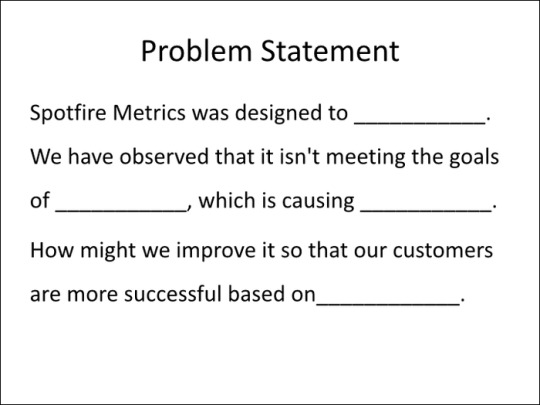
Determine What Data You Need to Solve The Problem
What data will help you determine how to get users to stop needing help in this scenario? Do you need to look at where customers are reaching for help? Or do you need to know why they are reaching for help? Or do you need both?
Quantitative data is often useful for exploring an issue. It helps you understand the thought processes of the user. Qualitative data will generally provide a more detailed answer to a problem; what’s the cause of the problem? How many people have the problem as a percentage of users?
Are you looking to work out what your users are doing? Or are you seeking their opinion on what they’re doing? The two are quite different things.
Select the Research Technique that Gives You The Easiest Path to Reliable Data
When you know what you’re trying to solve and what data will help you solve the issue; it should be easy to choose a methodology.
You want to choose a method that delivers the data you need in the easiest manner possible. Hopefully, this will also maximize the use of your budget and keep deadlines to a minimum too.
A survey may be the simplest way to get to a qualitative measure if you understand the user’s needs to some extent but it might be a terrible way to try and understand the user’s needs from scratch (surveys – particularly those going to large groups – need to be tightly controlled to generate valuable data).
Interviews, on the other hand, are a great way to get to qualitative data that can quickly develop brand new ideas for solutions.
https://www.interaction-design.org/literature/article/how-do-you-choose-the-right-ux-research-technique
2 notes
·
View notes
Text
Qualitative Research
With qualitative research, you collect textual data. That’s words to you and me. It allows us to get an idea of themes and patterns that cannot easily be expressed numerically when we have no underlying data to ask quantitative questions on. So you might ask; “Which functionality would people expect in our help suite?” or “What’s the biggest frustration that users have with our current product?”
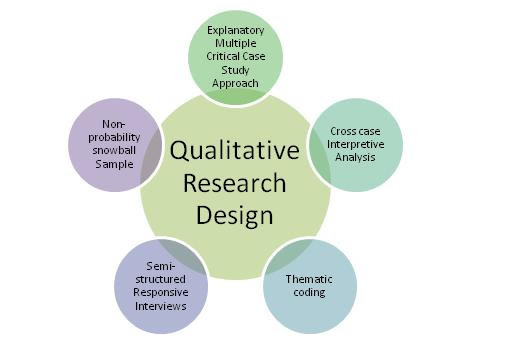
https://www.interaction-design.org/literature/article/how-do-you-choose-the-right-ux-research-technique
1 note
·
View note
Text
Quantitative Research
Quantitative research is defined as research that produces numerical data. It can normally be expressed in a statistical or percentage format. It’s a great way to get a specific answer to a specific question. E.g. “What percentage of our users are stay at home mums?” or “What proportion of our users has a disposable income of more than $1,000 a month?”
https://www.interaction-design.org/literature/article/how-do-you-choose-the-right-ux-research-technique
0 notes
Quote
There is simply no better method to build empathy for user problems than interviewing users in person, in their natural context.
https://uxmag.com/articles/5-steps-to-successful-enterprise-ux-research
0 notes
